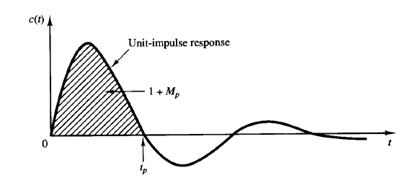SKEDSOFT
Impulse response of second-order systems:

Fig: 3
For the critically damped and overdamped cases, the unit-impulse response is always positive or zero; that is, c(t) ≥O. This can be seen from Equations above. For the underdamped case, the unit impulse response c(t) oscillates about zero and takes both positive and negative values. From the foregoing analysis, we may conclude that if the impulse response c(t) does not change sign, the system is either critically damped or overdamped, in which case the corresponding step response does not overshoot but increases or decreases monotonically and approaches a constant value.
The maximum overshoot for the unit-impulse response of the underdamped system occurs at

Since the unit-impulse response function is the time derivative of the unit-step response function, the maximum overshoot Mp for the unit-step response can be found from the corresponding unit-impulse response. That is, the area under the unit-impulse response curve from t = 0 to the time of the first zero, as shown in Figure 3, is  , where Mp is the maximum overshoot (for the unit-step response) given by Equation
, where Mp is the maximum overshoot (for the unit-step response) given by Equation

The peak time tp (for the unit-step response) given by Equation

corresponds to the time that the unit-impulse response first crosses the time axis.